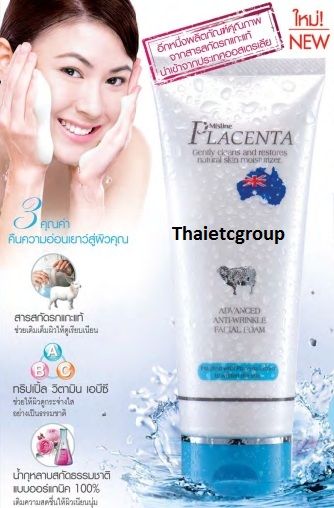|

 Advanced Anti-Wrinkle Facial Foam. Enriched with Placenta Extract to whiten the skin. Gently cleanses and restores natural skin moisturizer. What is the Benefit of Sheep Placenta ? Sheep placenta has been used for many years to promote general health. It is also typically used by consumers to produce clear and healthy skin, free of wrinkles and blemishes. Although many people disagree on the benefits of this extract, in many areas of the world, it is thought to be a natural way to reduce the toll that age takes on the body. Like all mammals, when a sheep becomes pregnant, a placenta forms inside of her uterus. This placenta helps to provide nutrients and oxygen to the unborn lamb, and is also responsible for helping to get rid of any waste that is produced. All of the nutrients in the sheep placenta help the unborn lamb to grow, but when the placenta is extracted, some believe that it can also provide numerous benefits to human health. Every placenta produced by pregnant mammals contains vitamins and nutrients, but sheep placentas tend to be more accessible and more nutrient-rich.
Description: Mistine Placenta Whitening Facial Foam
Condition : Brand new, never opened or used
Size : 80 grams each x 3 = 240 grams
Quantity : 3 tubes
Directions : Use twice daily as face foam.
Ingredients : Water, Stearic Acid, Palmitic Acid, Lauric Acid, Glycerin, Potassium Hydroxide, Sodium Laureth Sulfate, L auramide DEA, Potassium Laureth Phosphate, Myristic Acid, Dipropylene Glycol, Fragrance, Acrylates/C10-30 Alkyl Acrylate Crosspolymer, Sodium Sulfate, Methylparaben, Glycol Stearate, Capric Acid, Methylsothiazolinone, Ascorbil Glucoside, Niacinamide, Rosa Damascena Flower Water, Hydrogenated Polyisobutene, Sodium Hyaluronate, Butylene Glycol, Propylene Glycol, Retinyl Palmitate, Placenta Protein, Arachis Hypogaea (Peanut) Oil, Lepidium Sativum Sprout Extract, Polysorbate 80, Alcohol Denat, Lecithin, Ubiquinone, Tocopherol, Phenoxyethanol, Hydrolyzed Collagen, Sodium Benzoate, Potassium Sorbate, Genistein, pinus Pinaster Bark Extract
|